engine RENAULT KANGOO 2016 X61 / 2.G Owner's Guide
[x] Cancel search | Manufacturer: RENAULT, Model Year: 2016, Model line: KANGOO, Model: RENAULT KANGOO 2016 X61 / 2.GPages: 173, PDF Size: 3.8 MB
Page 102 of 173
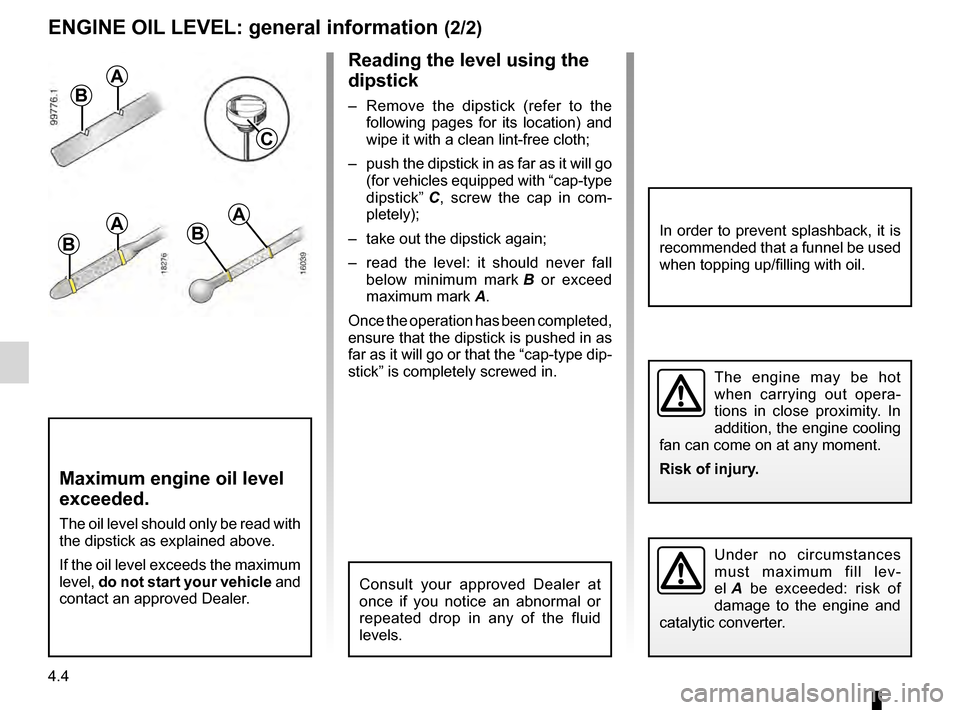
4.4
ENG_UD13985_2
Niveau huile moteur (X76 - Renault)
ENG_NU_854-2_X76LL_Renault_4
Consult your approved Dealer at
once if you notice an abnormal or
repeated drop in any of the fluid
levels.
engIne OIL LeveL: general information (2/2)
A
B
A
B
C
B
A
Reading the level using the
dipstick
– Remove the dipstick (refer to the
following pages for its location) and
wipe it with a clean lint-free cloth;
–
push the dipstick in as far as it will go
(for vehicles equipped with “cap-type
d
ipstick” C , screw the cap in com-
pletely);
–
take out the dipstick again;
– read the level: it should never fall
b
elow minimum mark B or exceed
maximum mark
A.
Once the operation has been completed,
ensure that the dipstick is pushed in as
far as it will go or that the “cap-type dip-
stick” is completely screwed in.
Maximum engine oil level
exceeded.
The oil level should only be read with
the dipstick as explained above.
If the oil level exceeds the maximum
level, do not start your vehicle and
contact an approved Dealer.
Under no circumstances
must maximum fill lev-
e
l A be exceeded: risk of
damage to the engine and
catalytic converter.
The engine may be hot
when carrying out opera-
tions in close proximity. In
addition, the engine cooling
fan can come on at any moment.
Risk of injury.
In order to prevent splashback, it is
recommended that a funnel be used
when topping up/filling with oil.
Page 103 of 173
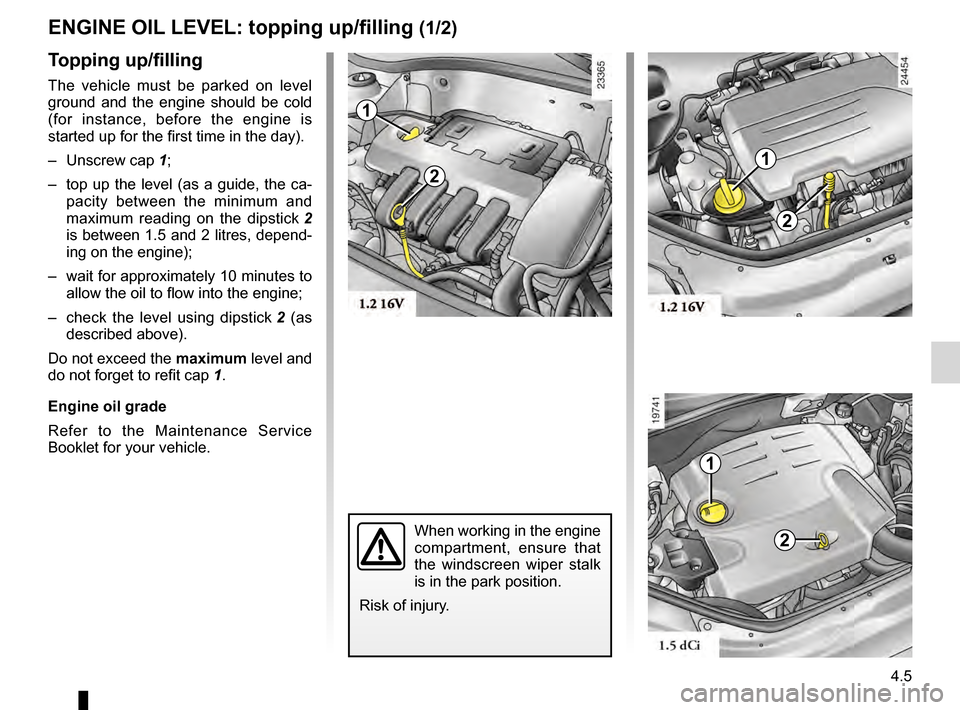
engine oil .............................................. (up to the end of the DU)
engine oil level ...................................... (up to the end of the DU) 4.5
ENG_UD14841_1
NIVEAU HUILE MOTEUR : appoint, remplissage (X76 - Renault)
ENG_NU_854-2_X76LL_Renault_4
topping up/filling
t opping up/filling
The vehicle must be parked on level
ground and the engine should be cold
(for instance, before the engine is
started up for the first time in the day).
–
Unscrew cap 1;
–
top up the level (as a guide, the ca -
pacity between the minimum and
m
aximum reading on the dipstick 2
is between 1.5 and 2 litres, depend-
ing on the engine);
–
wait for approximately 10 minutes to
allow the oil to flow into the engine;
–
check the level using dipstick 2 (as
described above).
Do not exceed the maximum level and
do not forget to refit cap
1.
e
ngine oil grade
Refer to the Maintenance Service
Booklet for your vehicle.
engIne OIL LeveL: topping up/filling (1/2)
1
2
1
2
When working in the engine
compartment, ensure that
the windscreen wiper stalk
is in the park position.
Risk of injury.
1
2
Page 104 of 173
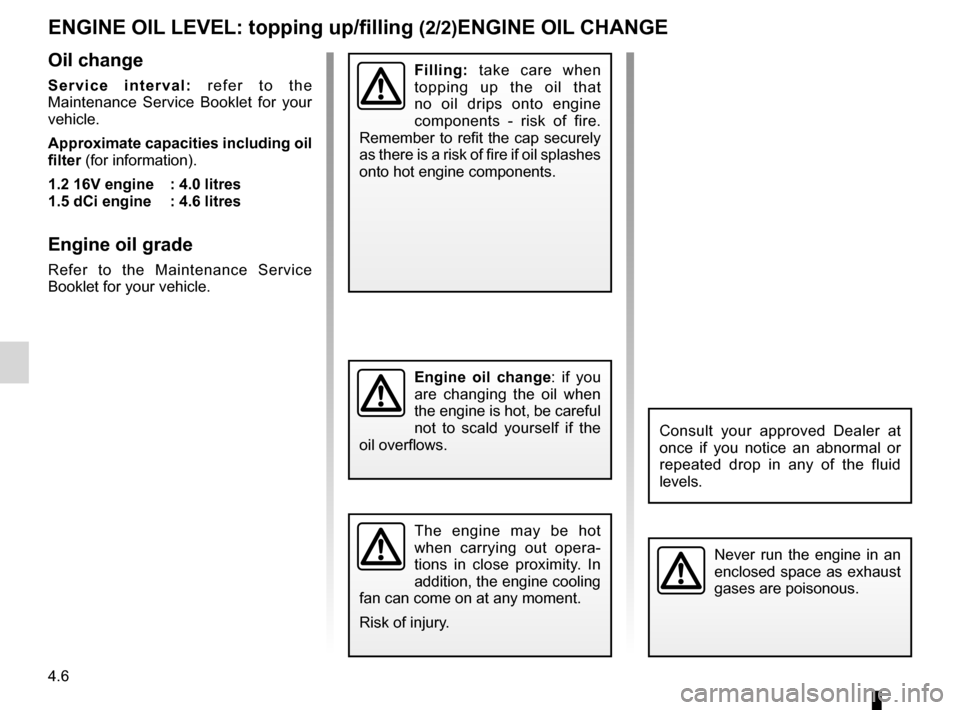
oil change .............................................................. (current page)
4.6
ENG_UD14841_1
NIVEAU HUILE MOTEUR : appoint, remplissage (X76 - Renault)
ENG_NU_854-2_X76LL_Renault_4
Engine oil change
engIne OIL LeveL: topping up/filling (2/2)engIne OIL ChAnge
Consult your approved Dealer at
once if you notice an abnormal or
repeated drop in any of the fluid
levels.
Never run the engine in an
enclosed space as exhaust
gases are poisonous.
engine oil change : if you
are changing the oil when
the engine is hot, be careful
not to scald yourself if the
oil overflows.
Filling: take care when
topping up the oil that
no oil drips onto engine
components - risk of fire.
Remember to refit the cap securely
as there is a risk of fire if oil splashes
onto hot engine components.Oil change
S e r v i c e i n t e r v a l : r e f e r t o t h e
Maintenance Service Booklet for your
vehicle.
Approximate capacities including oil
filter (for information).
1.2 16
v engine
: 4.0 litres
1.5 dCi engine : 4.6 litres
engine oil grade
Refer to the Maintenance Service
Booklet for your vehicle.
The engine may be hot
when carrying out opera-
tions in close proximity. In
addition, the engine cooling
fan can come on at any moment.
Risk of injury.
Page 105 of 173
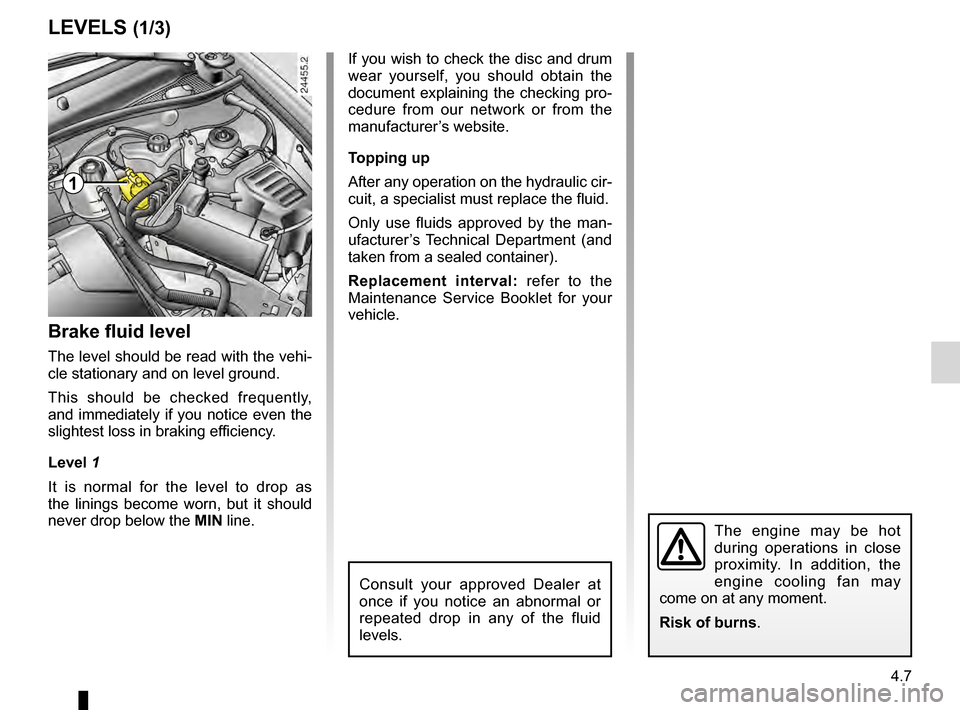
4.7
ENG_UD14325_2
Niveaux / Filtres (X76 - Renault)
ENG_NU_854-2_X76LL_Renault_4
Levels
The engine may be hot
during operations in close
proximity. In addition, the
engine cooling fan may
come on at any moment.
Risk of burns.
If you wish to check the disc and drum
wear yourself, you should obtain the
document explaining the checking pro-
cedure from our network or from the
manufacturer’s website.
t opping up
After any operation on the hydraulic cir-
cuit, a specialist must replace the fluid.
Only use fluids approved by the man-
ufacturer’s Technical Department (and
taken from a sealed container).
Replacement interval: refer to the
Maintenance Service Booklet for your
vehicle.
Brake fluid level
The level should be read with the vehi-
cle stationary and on level ground.
This should be checked frequently,
and immediately if you notice even the
slightest loss in braking efficiency.
Level
1
It is normal for the level to drop as
the linings become worn, but it should
never drop below the MI
n line.
LeveLS (1/3)
1
Consult your approved Dealer at
once if you notice an abnormal or
repeated drop in any of the fluid
levels.
Page 106 of 173
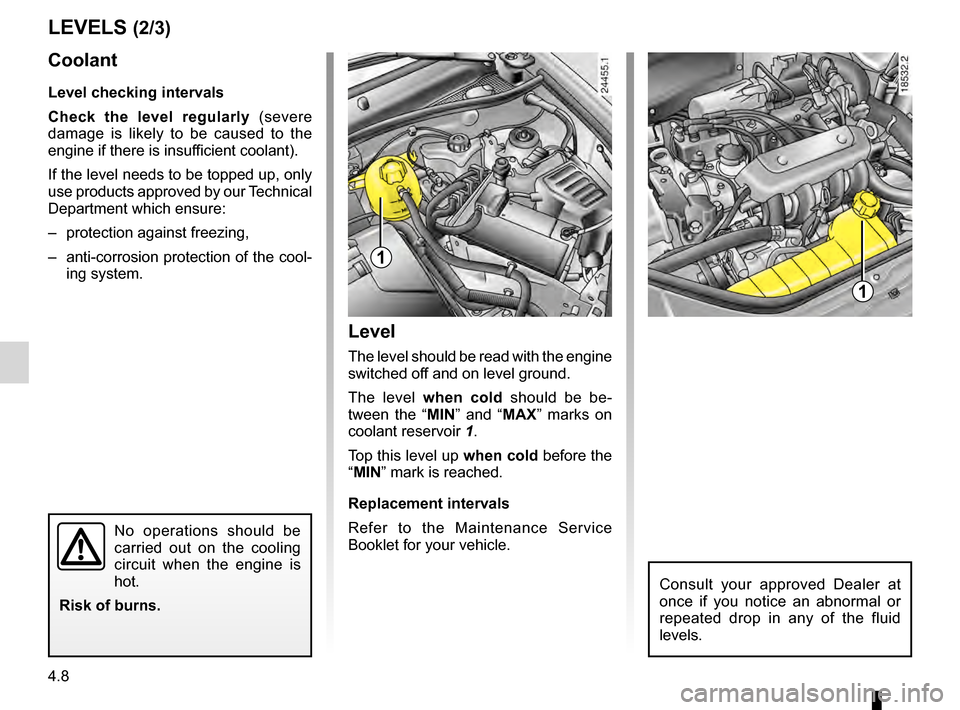
4.8
ENG_UD14325_2
Niveaux / Filtres (X76 - Renault)
ENG_NU_854-2_X76LL_Renault_4
Jaune NoirNoir texte
Coolant
Level checking intervals
Check the level regularly (severe
damage is likely to be caused to the
engine if there is insufficient coolant).
If the level needs to be topped up, only
use products approved by our Technical
Department which ensure:
–
protection against freezing,
– anti-corrosion protection of the cool -
ing system.
Consult your approved Dealer at
once if you notice an abnormal or
repeated drop in any of the fluid
levels.
No operations should be
carried out on the cooling
circuit when the engine is
hot.
Risk of burns.
Level
The level should be read with the engine
switched off and on level ground.
The level when cold should be be-
tween the “ M
In ” and “ MAX” marks on
coolant reservoir
1.
Top this level up when cold before the
“MI
n” mark is reached.
Replacement intervals
Refer to the Maintenance Service
Booklet for your vehicle.
LeveLS (2/3)
1
1
Page 107 of 173
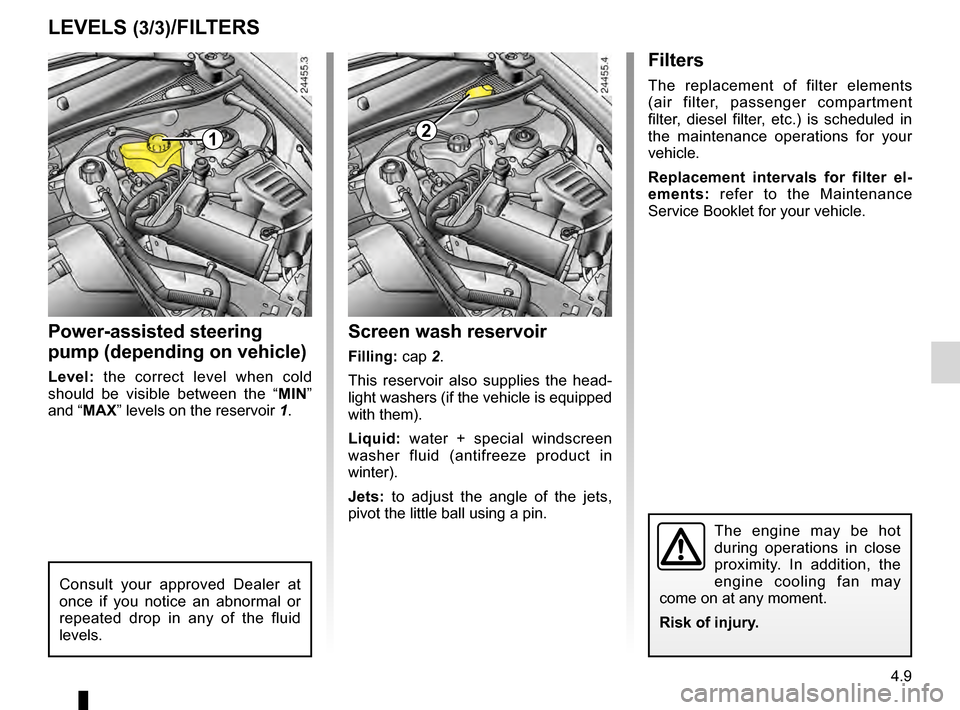
JauneNoirNoir texte
4.9
ENG_UD14325_2
Niveaux / Filtres (X76 - Renault)
ENG_NU_854-2_X76LL_Renault_4
LeveLS (3/3)/FIL teRS
Filters
Power-assisted steering
pump (depending on vehicle)
Level: the correct level when cold
should be visible between the “ M In ”
and “MAX” levels on the reservoir 1.
1
Consult your approved Dealer at
once if you notice an abnormal or
repeated drop in any of the fluid
levels.
The engine may be hot
during operations in close
proximity. In addition, the
engine cooling fan may
come on at any moment.
Risk of injury.
2
Screen wash reservoir
Filling: cap 2.
This reservoir also supplies the head-
light washers (if the vehicle is equipped
with them).
Liquid: water + special windscreen
washer fluid (antifreeze product in
winter).
Jets: to adjust the angle of the jets,
pivot the little ball using a pin.
Filters
The replacement of filter elements
(air filter, passenger compartment
filter, diesel filter, etc.) is scheduled in
the maintenance operations for your
vehicle.
Replacement intervals for filter el-
ements: refer to the Maintenance
Service Booklet for your vehicle.
Page 108 of 173
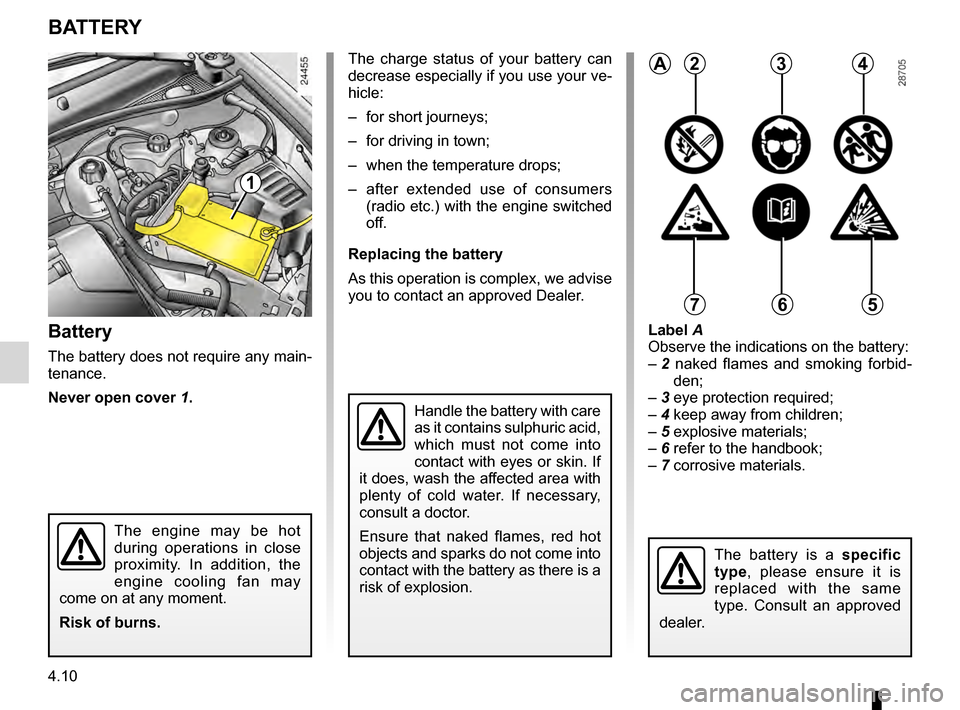
4.10
ENG_UD14326_1
Batterie (X76 - Renault)
ENG_NU_854-2_X76LL_Renault_4
Battery
BA tteR y
1
Battery
The battery does not require any main-
tenance.
n
ever open cover 1.
The engine may be hot
during operations in close
proximity. In addition, the
engine cooling fan may
come on at any moment.
Risk of burns.
Label A
Observe the indications on the battery:
– 2 n
aked flames and smoking forbid-
den;
–
3 eye protection required;
–
4 keep away from children;
–
5 explosive materials;
–
6 refer to the handbook;
–
7 corrosive materials.
The charge status of your battery can
decrease especially if you use your ve-
hicle:
–
for short journeys;
– for driving in town;
– when the temperature drops;
– after extended use of consumers
(radio etc.) with the engine switched
off.
Replacing the battery
As this operation is complex, we advise
you to contact an approved Dealer.
2A34
657
Handle the battery with care
as it contains sulphuric acid,
which must not come into
contact with eyes or skin. If
it does, wash the affected area with
plenty of cold water. If necessary,
consult a doctor.
Ensure that naked flames, red hot
objects and sparks do not come into
contact with the battery as there is a
risk of explosion.
The battery is a specific
type , please ensure it is
replaced with the same
type. Consult an approved
dealer.
Page 109 of 173
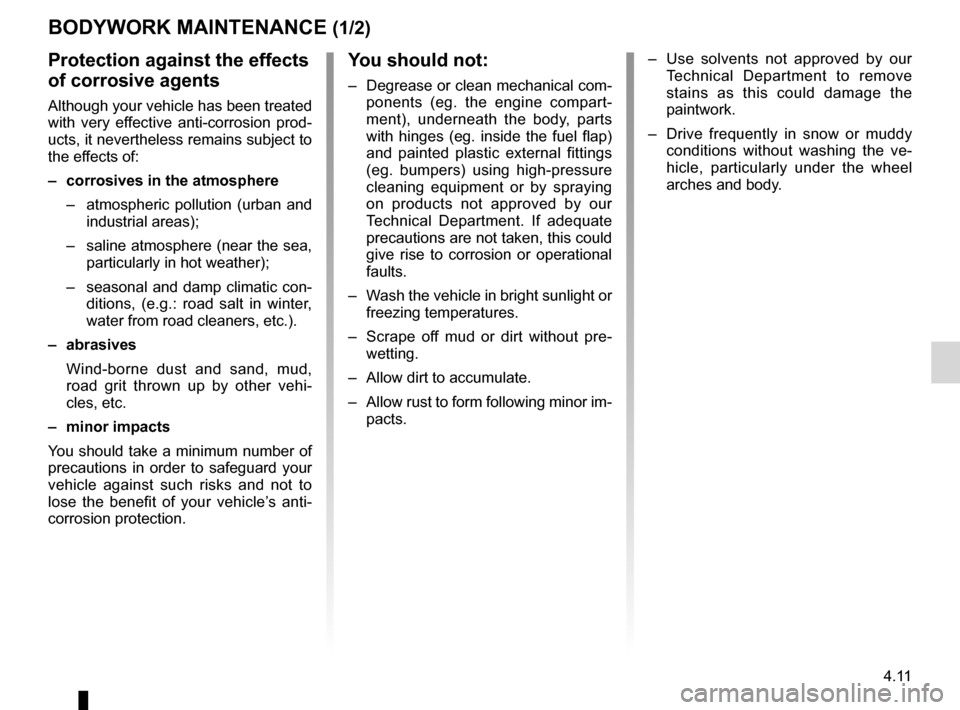
maintenance:bodywork ........................................ (up to the end of the DU)
washing ................................................ (up to the end of the DU)
paintwork maintenance ................................... (up to the end of the DU)
anti-corrosion protection ........................................ (current page) 4.11
ENG_UD7309_1
Entretien de la carrosserie (X76 - Renault)
ENG_NU_854-2_X76LL_Renault_4
Bodywork maintenance
BOdywORk MAIntenAnCe (1/2)
– Use solvents not approved by our
Technical Department to remove
stains as this could damage the
paintwork.
–
Drive frequently in snow or muddy
conditions without washing the ve-
hicle, particularly under the wheel
arches and body.
y ou should not:
– Degrease or clean mechanical com-
ponents (eg. the engine compart-
ment), underneath the body, parts
with hinges (eg. inside the fuel flap)
and painted plastic external fittings
(eg. bumpers) using high-pressure
cleaning equipment or by spraying
on products not approved by our
Technical Department. If adequate
precautions are not taken, this could
give rise to corrosion or operational
faults.
–
Wash the vehicle in bright sunlight or
freezing temperatures.
–
Scrape off mud or dirt without pre -
wetting.
–
Allow dirt to accumulate.
– Allow rust to form following minor im -
pacts.
Protection against the effects
of corrosive agents
Although your vehicle has been treated
with very effective anti-corrosion prod-
ucts, it nevertheless remains subject to
the effects of:
–
corrosives in the atmosphere
– atmospheric pollution (urban and
industrial areas);
–
saline atmosphere (near the sea,
particularly in hot weather);
–
seasonal and damp climatic con -
ditions, (e.g.: road salt in winter,
water from road cleaners, etc.).
–
abrasives
Wind-borne dust and sand, mud,
road grit thrown up by other vehi-
cles, etc.
–
minor impacts
You should take a minimum number of
precautions in order to safeguard your
vehicle against such risks and not to
lose the benefit of your vehicle’s anti-
corrosion protection.
Page 110 of 173
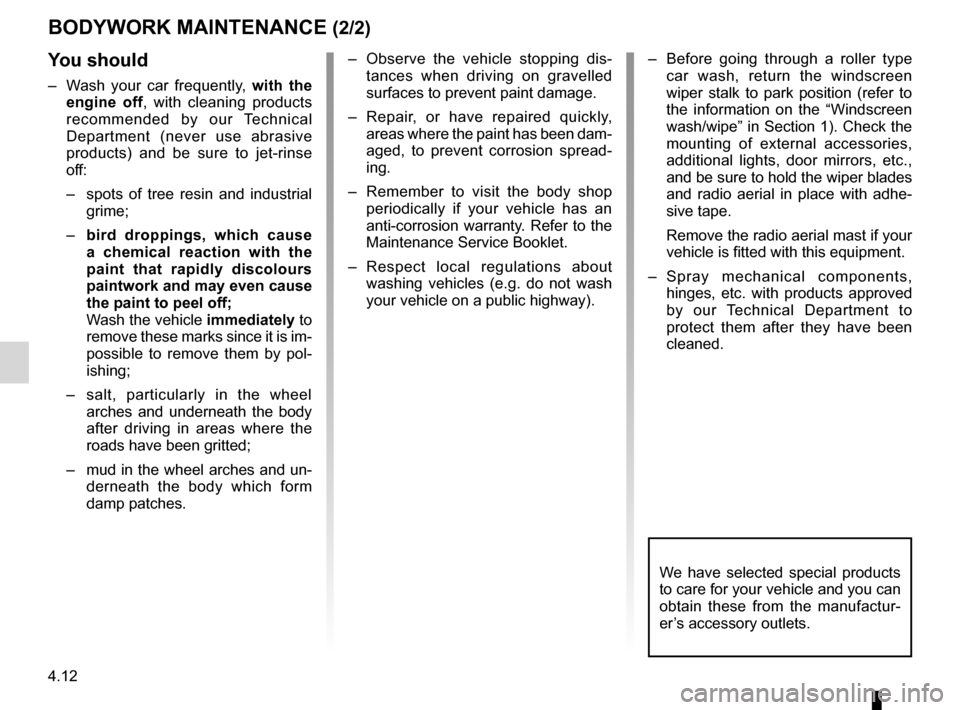
4.12
ENG_UD7309_1
Entretien de la carrosserie (X76 - Renault)
ENG_NU_854-2_X76LL_Renault_4
BOdywORk MAIntenAnCe (2/2)
– Before going through a roller type
car wash, return the windscreen
wiper stalk to park position (refer to
the information on the “Windscreen
wash/wipe” in Section 1). Check the
mounting of external accessories,
additional lights, door mirrors, etc.,
and be sure to hold the wiper blades
and radio aerial in place with adhe-
sive tape.
Remove the radio aerial mast if your
vehicle is fitted with this equipment.
–
Spray mechanical components,
hinges, etc. with products approved
by our Technical Department to
protect them after they have been
cleaned.
We have selected special products
to care for your vehicle and you can
obtain these from the manufactur-
er’s accessory outlets.
– Observe the vehicle stopping dis-
tances when driving on gravelled
surfaces to prevent paint damage.
–
Repair, or have repaired quickly,
areas where the paint has been dam-
aged, to prevent corrosion spread-
ing.
–
Remember to visit the body shop
periodically if your vehicle has an
anti-corrosion warranty. Refer to the
Maintenance Service Booklet.
–
Respect local regulations about
washing vehicles (e.g. do not wash
your vehicle on a public highway).
y ou should
– Wash your car frequently, with the
engine off , with cleaning products
recommended by our Technical
Department (never use abrasive
products) and be sure to jet-rinse
off:
–
spots of tree resin and industrial
grime;
–
bird droppings, which cause
a chemical reaction with the
paint that rapidly discolours
paintwork and may even cause
the paint to peel off;
Wash the vehicle immediately to
remove these marks since it is im-
possible to remove them by pol-
ishing;
–
salt, particularly in the wheel
arches and underneath the body
after driving in areas where the
roads have been gritted;
–
mud in the wheel arches and un -
derneath the body which form
damp patches.
Page 114 of 173
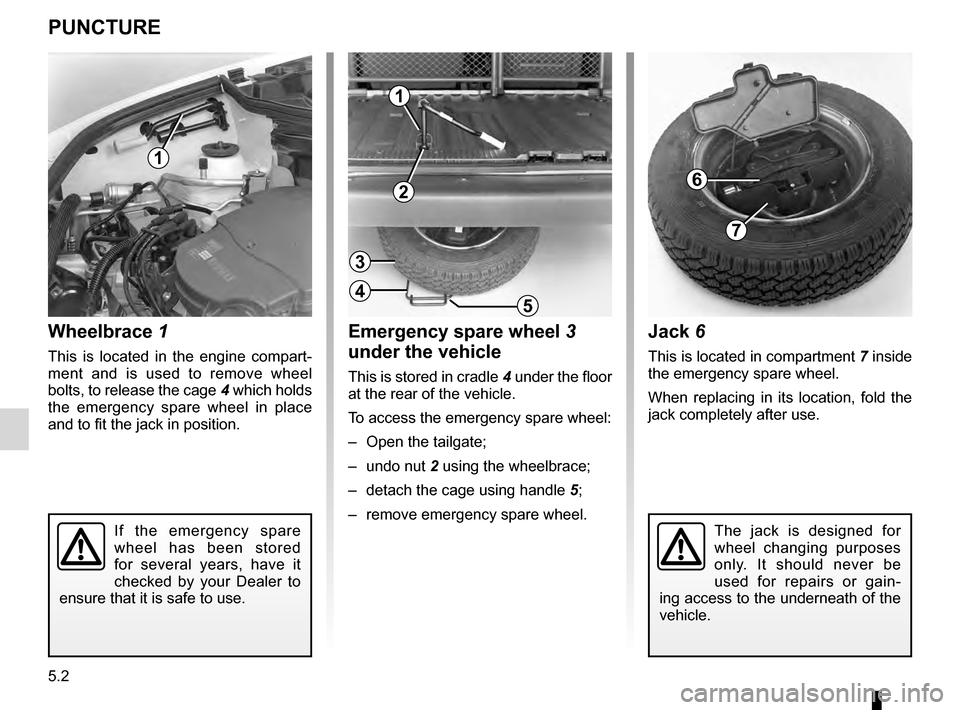
practical advice ..................................... (up to the end of the DU)
puncture................................................ (up to the end of the DU)
jack ....................................................... (up to the end of the DU)
wheelbrace ............................................................ (current page)
emergency spare wheel ....................... (up to the end of the DU)
5.2
ENG_UD7312_1
Roue de secours (X76 - Renault)
ENG_NU_854-2_X76LL_Renault_5
Puncture
The jack is designed for
wheel changing purposes
only. It should never be
used for repairs or gain-
ing access to the underneath of the
vehicle.If the emergency spare
wheel has been stored
for several years, have it
checked by your Dealer to
ensure that it is safe to use.
Jack 6
This is located in compartment 7 inside
the emergency spare wheel.
When replacing in its location, fold the
jack completely after use.
Emergency spare wheel 3
under
the vehicle
This is stored in cradle 4 under the floor
at the rear of the vehicle.
To access the emergency spare wheel:
–
Open the tailgate;
– undo nut 2 using the wheelbrace;
–
detach the cage using handle 5;
–
remove emergency spare wheel.
Wheelbrace 1
This is located in the engine compart-
ment and is used to remove wheel
bolts,
to release the cage 4 which holds
the emergency spare wheel in place
and to fit the jack in position.
PuncturE
1
1
2
3
45
6
7